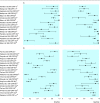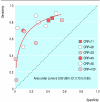Diagnostic value of C reactive protein in infections of the lower respiratory tract: systematic review
- PMID: 15979984
- PMCID: PMC558535
- DOI: 10.1136/bmj.38483.478183.EB
Diagnostic value of C reactive protein in infections of the lower respiratory tract: systematic review
Abstract
Objectives: To evaluate the diagnostic accuracy of C reactive protein in detecting radiologically proved pneumonia and to evaluate how well it can discriminate between bacterial and viral infections of the lower respiratory tract.
Data sources: Medline and Embase (January 1966 to April 2004), with reference checking.
Study selection: We included articles comparing C reactive protein with a chest radiograph or with microbiological work-up as a reference test. Two authors independently assessed methodological items.
Results: None of the studies met all validity criteria. Six studies used an infiltrate on chest radiograph as reference test. Sensitivities ranged from 10% to 98%, specificities from 44% to 99%. For adults, the relation of C reactive protein with an infiltrate (in a subgroup analysis of five studies) showed an area under the curve of 0.80 (95% confidence interval 0.75 to 0.85). In 12 studies, the relation of C reactive protein with a bacterial aetiology of infection of the lower respiratory tract was studied. Sensitivities ranged from 8% to 99%, specificities from 27% to 95%. These data were epidemiologically and statistically heterogeneous, so overall outcomes could not be calculated.
Conclusion: Testing for C reactive protein is neither sufficiently sensitive to rule out nor sufficiently specific to rule in an infiltrate on chest radiograph and bacterial aetiology of lower respiratory tract infection. The methodological quality of the diagnostic studies is generally poor. The evidence not consistently and sufficiently supports a wide introduction of C reactive protein as a rapid test to guide antibiotics prescription.
Figures



References
-
- Van de Lisdonk EH, Van den Bosch WJHM, Huygen FJA, Lagro-Janssen ALM, eds. Ziekten in de huisartspraktijk [Diseases in general practice]. Maarsen: Elsevier/Bunge, >1999.
-
- Metlay JP, Kapoor WN, Fine MJ. Does this patient have community-acquired pneumonia? Diagnosing pneumonia by history and physical examination. JAMA >1997;278: 1440-5. - PubMed
-
- Melbye H, Straume B, Aasebo U, Dale K. Diagnosis of pneumonia in adults in general practice. Relative importance of typical symptoms and abnormal chest signs evaluated against a radiographic reference standard. Scand J Prim Health Care >1992;10: 226-33. - PubMed
-
- Smucny JJ, Becker LA, Glazier RH, McIsaac W. Are antibiotics effective treatments for acute bronchitis? A meta-analysis. J Fam Pract >1998;47: 453-60. - PubMed
Publication types
MeSH terms
Substances
LinkOut - more resources
Full Text Sources
Other Literature Sources
Medical
Research Materials
Miscellaneous
